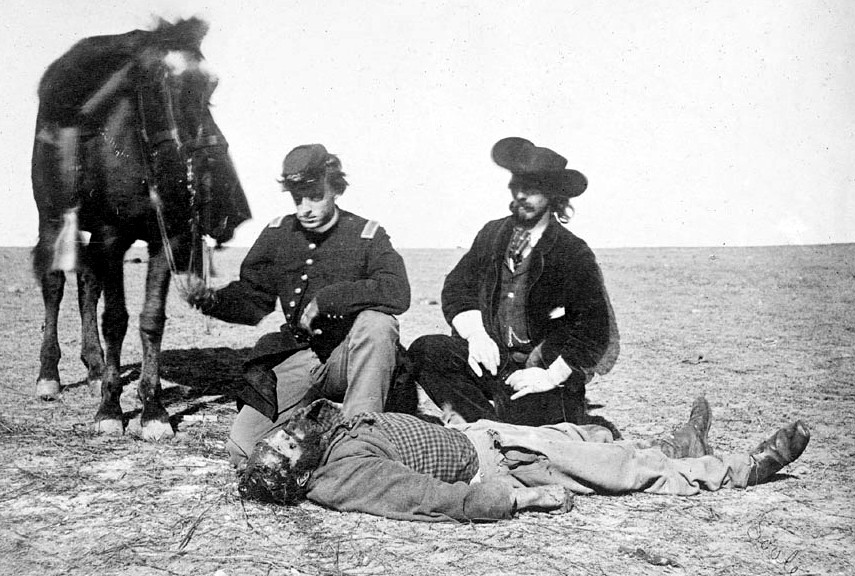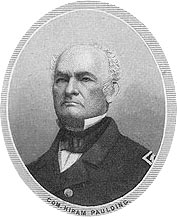|
Richard Irving Dodge
Richard Irving Dodge (May 19, 1827 – June 16, 1895) was a colonel in the United States Army. Dodge was born in North Carolina and died after a long and successful career in the U.S. Army. He began as a cadet in 1844 and retired as a Colonel May 19, 1891. Dodge was Aide-De-Camp to General William Tecumseh Sherman from 1881–1882. In the second publishing of his memoirs General Sherman wrote, "... the vacancy made by Colonel McCook was filled by Lieutenant-Colonel Richard Irving Dodge, Twenty-third Infantry then serving at a cantonment on the Upper Canadian—an officer who had performed cheerfully and well a full measure of frontier service, was a capital sportsman, and of a perfect war record. He also remained with me until his promotion as Colonel of the Eleventh Infantry, 26 January 1882." Life Dodge was born in Huntsville, North Carolina, in what was then Surry County, now Yadkin County. He was the eldest child and only son of James Richard Dodge and Susan Williams D ... [...More Info...] [...Related Items...] OR: [Wikipedia] [Google] [Baidu] |
Huntsville, North Carolina
Huntsville is a small unincorporated community in Yadkin County, North Carolina, United States. The community was formerly chartered in 1792 by Charles Hunt of Salisbury, NC and was chartered again in 1822 . It has a Huntsville Volunteer Fire Department, and Huntsville Community Center which is in front of a baseball/softball field which is home to Huntsville little league. History European settlers were drawn to the area as early as the 1740s because of the Shallow Ford, a natural gravel roadway under the Yadkin River. The Shallow Ford, which became part of the Great Wagon Road, was the only place in the vicinity that was shallow enough for heavy wagons to cross. When a road was extended from the Moravian settlement of Bethabara to the Shallow Ford in 1753, the village just west of the river became a frequent stop on the stagecoach trail. From the crossing, settlers could continue to Salisbury and Charlotte then on as far south as Georgia. In 1770, the Shallow Ford became part ... [...More Info...] [...Related Items...] OR: [Wikipedia] [Google] [Baidu] |
William Paulding, Jr
William is a masculine given name of Norman French origin.Hanks, Hardcastle and Hodges, ''Oxford Dictionary of First Names'', Oxford University Press, 2nd edition, , p. 276. It became very popular in the English language after the Norman conquest of England in 1066,All Things William"Meaning & Origin of the Name"/ref> and remained so throughout the Middle Ages and into the modern era. It is sometimes abbreviated "Wm." Shortened familiar versions in English include Will, Wills, Willy, Willie, Liam, Bill, and Billy. A common Irish form is Liam. Scottish diminutives include Wull, Willie or Wullie (as in Oor Wullie or the play ''Douglas''). Female forms are Willa, Willemina, Wilma and Wilhelmina. Etymology William is related to the German given name ''Wilhelm''. Both ultimately descend from Proto-Germanic ''*Wiljahelmaz'', with a direct cognate also in the Old Norse name ''Vilhjalmr'' and a West Germanic borrowing into Medieval Latin ''Willelmus''. The Proto-Germanic name is a ... [...More Info...] [...Related Items...] OR: [Wikipedia] [Google] [Baidu] |
Fort Dodge (US Army Post)
The site of Fort Dodge in the U.S. state of Kansas was originally an old campground for wagons traveling along the Santa Fe Trail, just west of the western junction of the Wet and Dry Routes and near the middle or Cimarron Cutoff. On March 23, 1865, Major General Grenville M. Dodge, who commanded the 11th and 16th Kansas Cavalry Regiments, wrote to Colonel James Hobart Ford to propose establishing a new military post west of Fort Larned. On orders of Col. Ford, Captain Henry Pearce, with Company C, Eleventh Cavalry Regiment, and Company F, Second U.S. Volunteer Infantry, from Fort Larned, occupied and established Fort Dodge on April 10, 1865. History Fort Dodge was named for General Grenville M. Dodge. General Dodge wrote in his autobiography: "Fort Dodge was named after me, not as an honor, by a command that I was sent out there in the winter, after it was too late to furnish them lumber or anything for an encampment and they had to make dug-outs in the Bluffs for the purp ... [...More Info...] [...Related Items...] OR: [Wikipedia] [Google] [Baidu] |
Dodge City
Dodge City is the county seat of Ford County, Kansas, United States, named after nearby Fort Dodge. As of the 2020 census, the population of the city was 27,788. The city is famous in American culture for its history as a wild frontier town of the Old West. History The first settlement in the area that became Dodge City was Fort Mann, built by civilians in 1847. At that time the territory was part of Mexico, and the fort was built to provide protection for travelers on the Santa Fe Trail. Fort Mann collapsed in 1848 after an attack by Natives. In 1850, the U.S. Army arrived to provide protection in the region and constructed Fort Atkinson on the old Fort Mann site. The army abandoned Fort Atkinson in 1853. Military forces on the Santa Fe Trail were re-established farther north and east at Fort Larned in 1859, but the area remained vacant around what would become Dodge City until the end of the Civil War. In April, 1865, the American Frontier Wars in the West began he ... [...More Info...] [...Related Items...] OR: [Wikipedia] [Google] [Baidu] |
Atchison, Topeka And Santa Fe Railway
The Atchison, Topeka and Santa Fe Railway , often referred to as the Santa Fe or AT&SF, was one of the larger railroads in the United States. The railroad was chartered in February 1859 to serve the cities of Atchison, Kansas, Atchison and Topeka, Kansas, and Santa Fe, New Mexico. The railroad reached the Kansas–Colorado border in 1873 and Pueblo, Colorado, in 1876. To create a demand for its services, the railroad set up real estate offices and sold farmland from the land grants that it was awarded by United States Congress, Congress. Despite being chartered to serve the city, the railroad chose to bypass Santa Fe, due to the engineering challenges of the mountainous terrain. Eventually Santa Fe Southern Railway, a branch line from Lamy, New Mexico, brought the Santa Fe railroad to its namesake city. The Santa Fe was a pioneer in intermodal freight transport; at various times, it operated an airline, the short-lived Santa Fe Skyway, and the fleet of Santa Fe Railroad Tugboa ... [...More Info...] [...Related Items...] OR: [Wikipedia] [Google] [Baidu] |
George Armstrong Custer
George Armstrong Custer (December 5, 1839 – June 25, 1876) was a United States Army officer and cavalry commander in the American Civil War and the American Indian Wars. Custer graduated from West Point in 1861 at the bottom of his class, but as the Civil War was just starting, trained officers were in immediate demand. He worked closely with General George B. McClellan and the future General Alfred Pleasonton, both of whom recognized his qualities as a cavalry leader, and he was promoted to brigadier general of volunteers at age 23. Only a few days after his promotion, he fought at the Battle of Gettysburg, where he commanded the Michigan Cavalry Brigade and despite being outnumbered, defeated J. E. B. Stuart's attack at what is now known as the East Cavalry Field. In 1864, he served in the Overland Campaign and in Philip Sheridan's army in the Shenandoah Valley, defeating Jubal Early at Cedar Creek. His division blocked the Army of Northern Virginia's final retreat an ... [...More Info...] [...Related Items...] OR: [Wikipedia] [Google] [Baidu] |
James Hobart Ford
James Hobart Ford (May 22, 1829 – January 12, 1867) was a Union colonel and brevet brigadier general during the American Civil War, notable for his contributions in the Trans-Mississippi Theater of the war. Early life James Hobart Ford was born in Painesville, Ohio, in 1829. His uncle was David Tod, U.S. Minister to Brazil and governor of Ohio during the Civil War. Much of Ford's early life is unclear, but sometime before 1861 he moved from Ohio to Colorado. He married in May 1850 to Arabella Stambaugh, daughter of John F. Stambaugh and Sara Beaver. They had 4 children, David Tod Ford, James R. Ford, John S. Ford and Sara Stambaugh Ford. Civil War New Mexico Ford became involved in the Civil War when Confederate forces invaded New Mexico. Colonel Edward Canby called for reinforcements from the nearby Colorado Territory to help in the defense of New Mexico. The people of Colorado responded quicklyAlberts, p. 13. and Ford took command of one company raised in Cañon City and ... [...More Info...] [...Related Items...] OR: [Wikipedia] [Google] [Baidu] |
Grenville M
Grenville may refer to: People British Prime Ministers * George Grenville (1712–1770), Prime Minister 1763–1765 * William Grenville, 1st Baron Grenville (1759–1834), his son, Prime Minister 1806–1807 Other people * Anne Grenville, Baroness Grenville (1772–1864), English noblewoman and author * Bevil Grenville (1596–1643), English soldier * Bruce Grenville ( Bruce Ronald Henderson, born 1950), New Zealand anarchist and hoaxer * Elizabeth Grenville (1719–1769), British artist and writer * George Grenville (other) * Georgina Grenville (born 1975), South African fashion model * Henry Grenville (1717–1784), British diplomat and politician * Hester Grenville, 1st Countess Temple, (c. 1690 – 1752) * Honor Grenville, Viscountess Lisle, (c. 1493–5 – 1566) * Kate Grenville (born 1950), Australian author * James Grenville (1715–1783), British politician * James Grenville, 1st Baron Glastonbury (1742–1825), British politician * Jane Grenville (born 1 ... [...More Info...] [...Related Items...] OR: [Wikipedia] [Google] [Baidu] |
Santa Fe Trail
The Santa Fe Trail was a 19th-century route through central North America that connected Franklin, Missouri, with Santa Fe, New Mexico. Pioneered in 1821 by William Becknell, who departed from the Boonslick region along the Missouri River, the trail served as a vital commercial highway until 1880, when the railroad arrived in Santa Fe. Santa Fe was near the end of El Camino Real de Tierra Adentro which carried trade from Mexico City. The trail was later incorporated into parts of the National Old Trails Road and U.S. Route 66. The route skirted the northern edge and crossed the north-western corner of Comancheria, the territory of the Comanche. Realizing the value, they demanded compensation for granting passage to the trail. American traders envisioned them as another market. Comanche raiding farther south in Mexico isolated New Mexico, making it more dependent on the American trade. They raided to gain a steady supply of horses to sell. By the 1840s, trail traffic through th ... [...More Info...] [...Related Items...] OR: [Wikipedia] [Google] [Baidu] |
John André
John André (2 May 1750/1751''Gravesite–Memorial'' Westminster Abbey webpage; accessed September 2020 – 2 October 1780) was a major in the and head of its Secret Service in America during the . He was as a by the |
John Paulding
John Paulding (October 16, 1758 – February 18, 1818) was an American militiaman from the state of New York during the American Revolution. In 1780, he was one of three men who captured Major John André, a British spy associated with the treason of Continental general and commandant of West Point Benedict Arnold. Andre was convicted and hanged.Cray, pp. 371-397Raymond, pp. 11-17 American Revolution While visiting his future wife, Sarah Tidd, Paulding was captured by Tories, or Loyalists, led by his future brother-in-law. He was held in the notorious "Sugar House" prison in New York City in 1780, then occupied by British forces. He escaped by jumping from a window. He went to the livery stable of a friend and acquired a German military Jäger or Hessian coat, green with red trim, associated with the British mercenaries, which he wore to evade notice. As part of an armed patrol in Westchester County, with fellow militiamen David Williams and Isaac Van Wart,Cray, pp. 371-397 ... [...More Info...] [...Related Items...] OR: [Wikipedia] [Google] [Baidu] |







